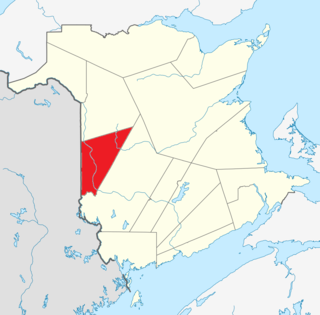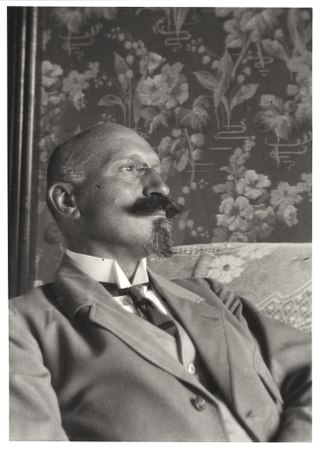
A covered bridge is a timber-truss bridge with a roof, decking, and siding, which in most covered bridges create an almost complete enclosure. The purpose of the covering is to protect the wooden structural members from the weather. Uncovered wooden bridges typically have a lifespan of only 20 years because of the effects of rain and sun, but a covered bridge can last over 100 years. In the United States, only about 1 in 10 survived the 20th century. The relatively small number of surviving bridges is due to deliberate replacement, neglect, and the high cost of restoration.

Mount Allison University is a Canadian primarily undergraduate liberal arts university located in Sackville, New Brunswick, founded in 1839.

Carleton County is located in west-central New Brunswick, Canada.

Hartland is a town in Carleton County, New Brunswick, Canada.

The flying buttress is a specific form of buttress composed of an arch that extends from the upper portion of a wall to a pier of great mass, in order to convey to the ground the lateral forces that push a wall outwards, which are forces that arise from vaulted ceilings of stone and from wind-loading on roofs.

Richard Bennett Hatfield was a New Brunswick politician and the longest serving premier of New Brunswick from 1970 to 1987.
Hugh John Flemming was a politician and the 24th premier of New Brunswick from 1952 to 1960.
James Kidd Flemming was a businessman and politician in New Brunswick, Canada.
Route 2 is a major provincial highway in the Canadian province of New Brunswick, carrying the main route of the Trans-Canada Highway in the province. The highway connects with Autoroute 85 at the border with Quebec and Highway 104 at the border with Nova Scotia, as well as with traffic from Interstate 95 in the U.S. state of Maine via the short Route 95 connector. A core route in the National Highway System, Route 2 is a four-lane freeway in its entirety, and directly serves the cities of Edmundston, Fredericton, and Moncton.

Rothesay is a provincial electoral district for the Legislative Assembly of New Brunswick, Canada. The riding consists of the Town of Rothesay and its surroundings.

Robert Maillart was a Swiss civil engineer who revolutionized the use of structural reinforced concrete with such designs as the three-hinged arch and the deck-stiffened arch for bridges, and the beamless floor slab and mushroom ceiling for industrial buildings. His Salginatobel (1929–1930) and Schwandbach (1933) bridges changed the aesthetics and engineering of bridge construction dramatically and influenced decades of architects and engineers after him. In 1991 the Salginatobel Bridge was declared an International Historic Civil Engineering Landmark by the American Society of Civil Engineers.

The Hartland Covered Bridge, otherwise known simply as the Hartland Bridge, is the world's longest covered bridge, measuring approximately 1,282 feet (391 m) long. Located in the Canadian province of New Brunswick, the bridge crosses the Saint John River from Hartland to Somerville, both located in Carleton County. The framework consists of seven small Howe Truss bridges joined on six piers. The bridge was designated a National Historic Sites of Canada in 1977, as well as a Provincial Heritage Place in New Brunswick under the Heritage Conservation Act in 1999.
Peel is a Canadian rural community in Carleton County, New Brunswick. It is located on the east side of the Saint John River, 5.71 km NNW of Hartland, on the road to Stickney. It is part of Peel Parish.

The Cornish–Windsor Covered Bridge is a 158-year-old, two-span, timber Town lattice-truss, interstate, covered bridge that crosses the Connecticut River between Cornish, New Hampshire, and Windsor, Vermont. Until 2008, when the Smolen–Gulf Bridge opened in Ohio, it had been the longest covered bridge in the United States.

The Saint John City Market in Saint John, New Brunswick, is the oldest continuously operated farmer's market in Canada, with a charter dating from 1785. The market is located at 47 Charlotte Street.
Aida Maud Boyer McAnn Flemming, was a Canadian teacher, writer and animal welfare advocate. She founded the Kindness Club, a humane education organization for children between the ages of 5 and 13. She was the wife of Hugh John Flemming, who was Premier of New Brunswick from 8 October 1952 to 11 July 1960.

Hugh John Alexander "Ted" Flemming is a Canadian politician, currently serving as MLA for the electoral district of Rothesay in New Brunswick. Flemming was elected to the legislature in a by-election on June 25, 2012.
The Becaguimec Stream is a minor tributary of the Saint John River in the Canadian Province of New Brunswick. It rises in the hilly woods along the county line dividing Carleton County, Canada from York County, Canada in the western region of the province. Its watershed is adjacent to the South Branch of the Southwest Miramichi River, the Nashwaak River, the Keswick River and the Nackawic Stream.

Best's Covered Bridge(akaSwallow's Bridge) is a historic covered bridge in West Windsor, Vermont, that carries Churchill Road over Mill Creek, just south of Vermont Route 44. Built in 1889, it is an architecturally distinctive laminated arch structure with a post-and-beam superstructure. It was listed on the National Register of Historic Places in 1973.














